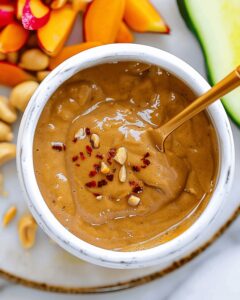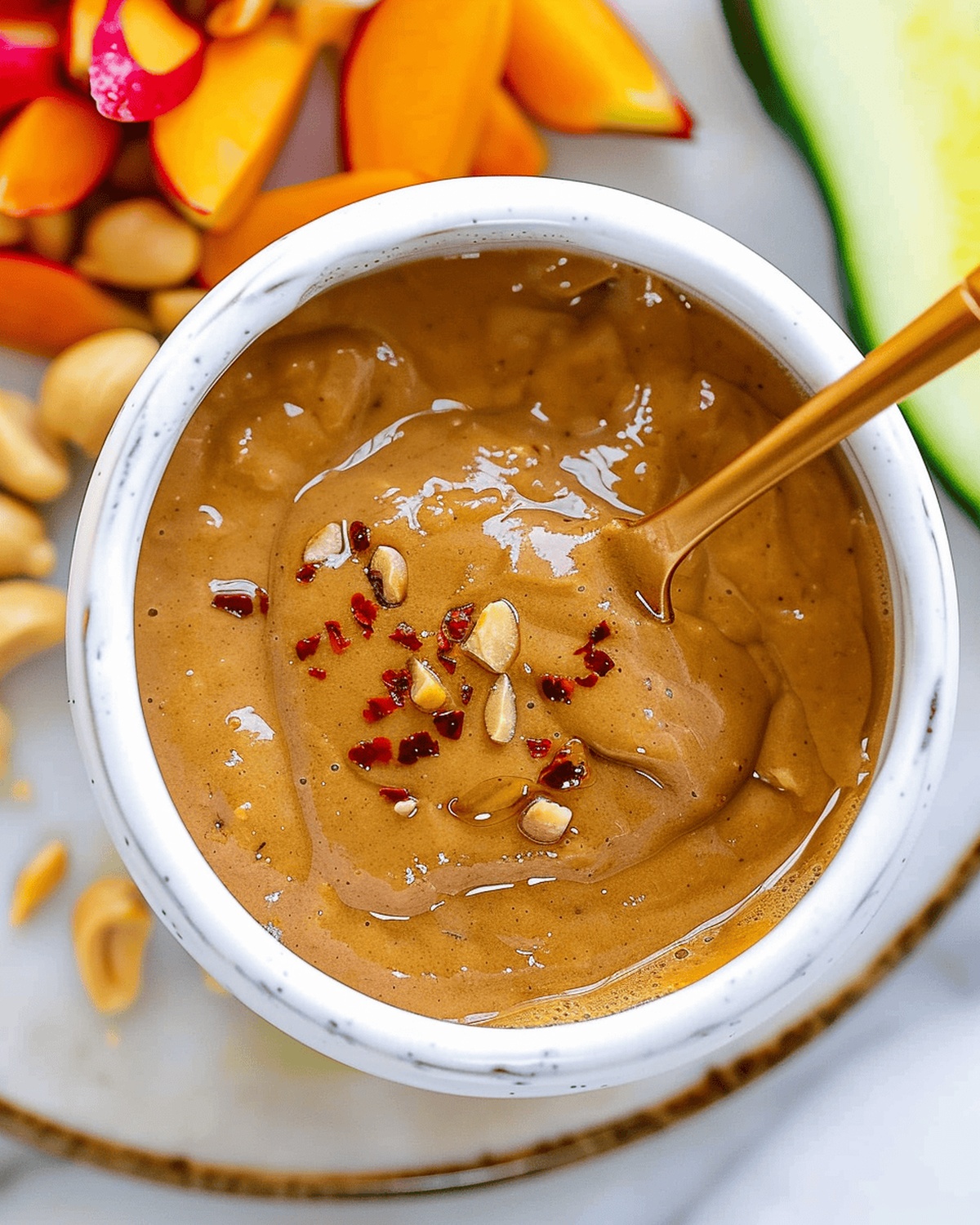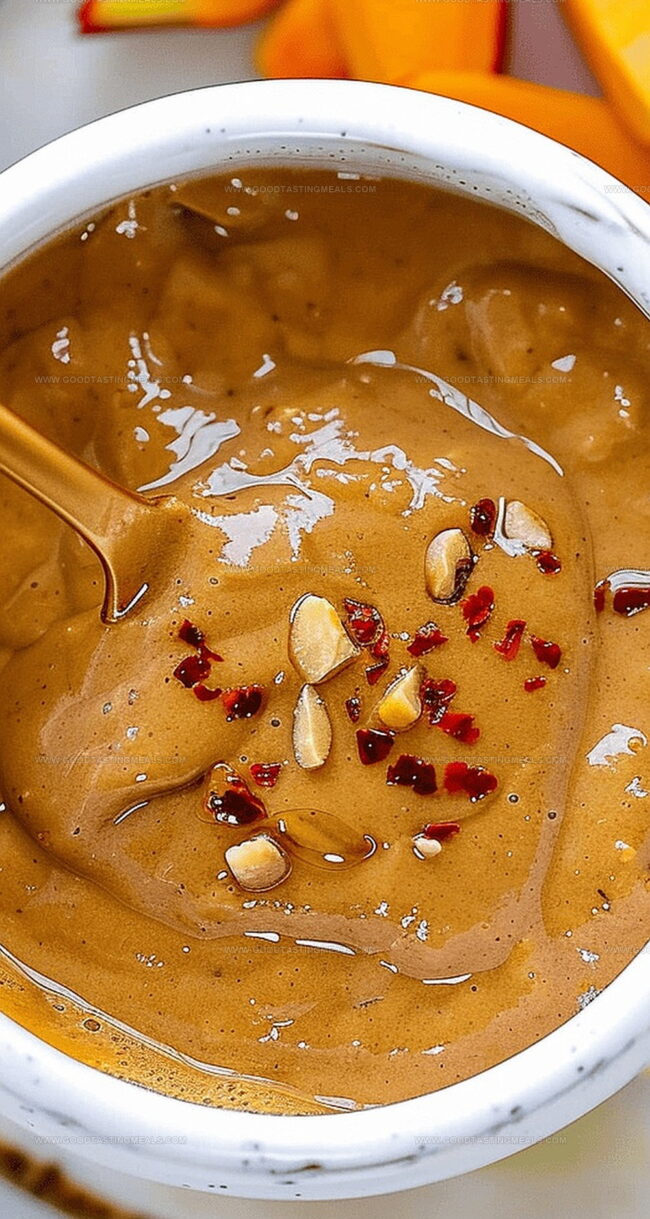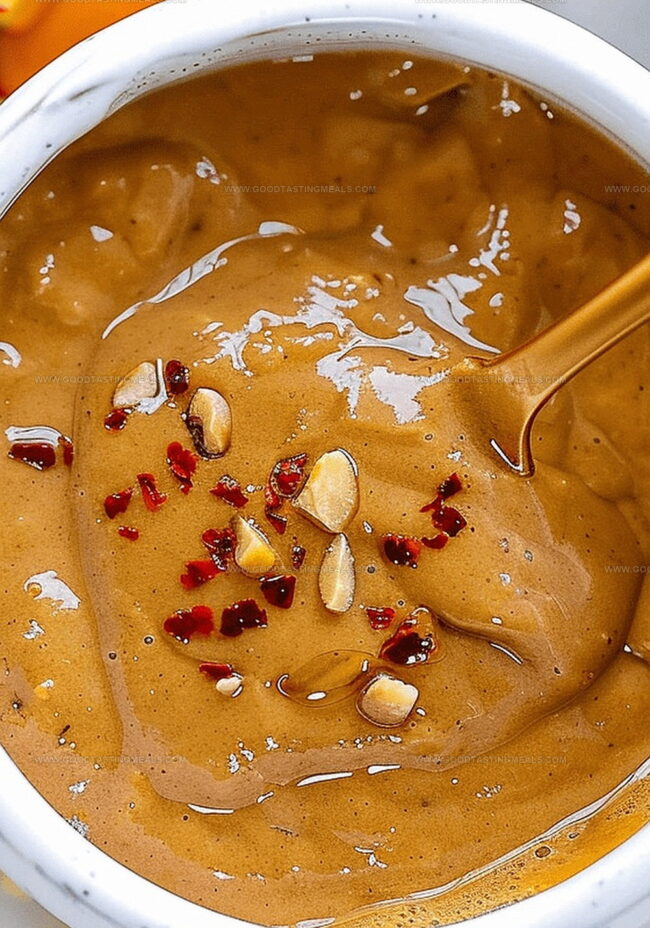The Best Thai Peanut Sauce Recipe: Creamy, Sweet & Spicy Magic
Thai peanut sauce brings vibrant flavors that dance across your palate with remarkable complexity.
Rich, creamy textures blend seamlessly with tangy and spicy undertones that elevate any dish.
Traditional ingredients create a harmonious symphony of taste sensations that feel both comforting and exciting.
Culinary enthusiasts appreciate how this versatile condiment revolutionizes ordinary meals into extraordinary experiences.
Balanced combinations of nutty, sweet, and savory elements make this sauce irresistibly addictive.
Cultural influences shine through every carefully crafted spoonful, connecting distant traditions with familiar comfort.
Each ingredient plays a crucial role in developing depth and character.
What Makes Best Thai Peanut Sauce So Addictive
Ingredients That Give Best Thai Peanut Sauce Its Flavor
Main Ingredients:
Peanut Butter Base:Liquid Base:Flavor Enhancers:Spice and Heat:How to Whisk Up the Best Thai Peanut Sauce at Home
Step 1: Crush and Mince Aromatic Champions
Peel and finely chop garlic and ginger using a sharp knife or microplane grater. The smaller the pieces, the more intense the flavor will be.
Step 2: Create Sauce Magic
In a medium mixing bowl, combine:Whisk ingredients together until they form a smooth, harmonious blend.
Step 3: Perfect the Consistency
Gradually pour warm water into the mixture, whisking continuously. Start with half a cup and adjust until you reach a silky, pourable texture that suits your culinary adventure.
Step 4: Taste and Customize
Sample your creation and fine-tune the flavors. Want more heat? Add extra red pepper flakes. Craving more sweetness? Drizzle in additional honey.
Step 5: Serve and Enjoy
Drizzle over noodles, use as a dipping sauce for vegetables, or slather on grilled proteins. This versatile sauce transforms any dish into a flavor explosion.
Pro Tips for Creamy Best Thai Peanut Sauce
Storing Best Thai Peanut Sauce for Everyday Use
What Dishes Pair Nicely with Best Thai Peanut Sauce
Fun Twists on the Best Thai Peanut Sauce Recipe
Print
Best Thai Peanut Sauce Recipe
- Total Time: 10 minutes
- Yield: 4 1x
Description
Spicy Thai peanut sauce brings bold Southeast Asian flavors to your kitchen. Creamy, tangy, and packed with zesty ingredients, this sauce offers a perfect balance of heat and richness you’ll crave again and again.
Ingredients
Main Ingredients:
- 0.75 cup peanut butter (made with just peanuts + salt)
- 0.5 cup warm water (to thin, or more as needed)
Flavor Enhancers:
- 3 tablespoons low sodium soy sauce or tamari
- 1 tablespoon toasted sesame oil (omit if you don’t want any sesame flavor)
- 1 tablespoon lime juice
- 2 tablespoons rice vinegar
- 1–2 tablespoons maple syrup
Spices and Aromatics:
- 0.5 teaspoon ground ginger
- 2 small cloves garlic, finely minced
- 0.25–0.5 teaspoon red pepper flakes
Instructions
- Crush garlic cloves using a press to ensure a fine, uniform texture, releasing maximum flavor into the mixing bowl.
- Combine all liquid and dry ingredients except water, vigorously whisking to create a smooth, homogeneous base that blends flavors harmoniously.
- Gradually introduce warm water, beginning with a modest amount, stirring continuously to achieve the ideal viscosity for your culinary application – whether a drizzling dressing or thick dipping sauce.
- Conduct a flavor assessment, fine-tuning the profile by incrementally adjusting seasonings – consider enhancing with additional soy sauce for depth, sweetener for balance, or red pepper flakes for a spicy kick.
- Present this versatile Thai-inspired sauce as a dynamic accompaniment to an array of dishes: toss with noodle bowls, drizzle over grilled proteins like tofu, tempeh, or chicken, enrich stir-fries, or offer as a vibrant dipping sauce alongside fresh, crisp vegetables.
Notes
- Garlic Mincing Matters: Use a garlic press for ultra-smooth texture, preventing annoying large chunks that disrupt the sauce’s silky consistency.
- Whisking Wisdom: Combine all ingredients except water first to create a perfect base, ensuring even blending of flavors.
- Liquid Leverage: Add warm water gradually, starting with ½ cup, to control sauce thickness for different culinary uses like dressing or dipping.
- Flavor Flexibility: Taste and tweak seasonings boldly – a splash more soy sauce, sweetener, or red pepper flakes can transform the sauce.
- Versatile Companion: Drizzle over noodle bowls, proteins like tofu, tempeh, or chicken, enhance stir-fries, or use as a vibrant vegetable dip.
- Storage Tip: Refrigerate in an airtight container for up to 5 days, allowing flavors to meld and intensify for even more deliciousness.
- Prep Time: 10 minutes
- Cook Time: 0 minutes
- Category: Snacks, Dinner
- Method: Blending
- Cuisine: Thai
Nutrition
- Serving Size: 4
- Calories: 224
- Sugar: 3g
- Sodium: 230mg
- Fat: 18g
- Saturated Fat: 3g
- Unsaturated Fat: 15g
- Trans Fat: 0g
- Carbohydrates: 10g
- Fiber: 2g
- Protein: 7g
- Cholesterol: 0mg




Liam O’Brien
Founder & Recipe Developer
Expertise
Education
Dublin Institute of Technology (now Technological University Dublin)
Ballymaloe Cookery School, County Cork, Ireland
Liam O’Brien is the co-founder and kitchen soul behind Good Tasting Meals, a chef who believes that cooking shouldn’t feel stressful or complicated.
He earned his culinary stripes at Technological University Dublin and polished his farm-to-table skills at Ballymaloe Cookery School. With over 15 years flipping pans and stirring up stories, Liam has worked in family cafés, bustling bistros, and everything in between.
At Good Tasting Meals, Liam brings you recipes that feel like home: cozy, simple, and full of flavor.